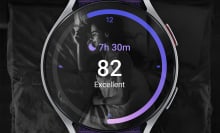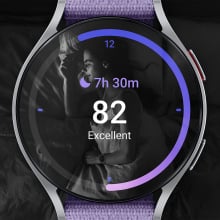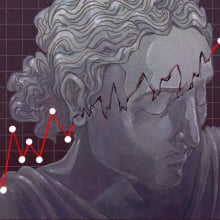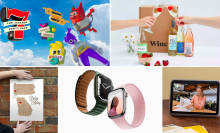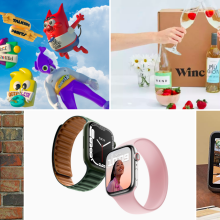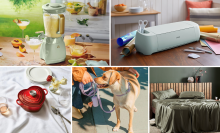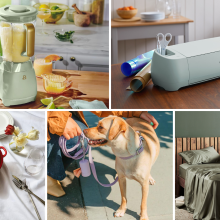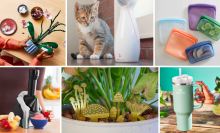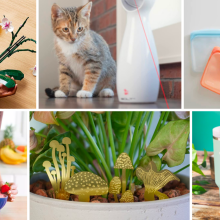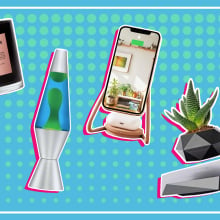Dear reader: I hope it isn't too sudden, or embarrassing, if I kneel before you and offer this ring. And that you don't mind if I also offer a long list of caveats before you choose whether to accept it. After all, it's best to start any new relationship in a spirit of full disclosure.
For a long-term relationship is what you would be aiming at with the Oura 3, the latest and (so far) greatest release in the so-hot-right-now genre of wearables known as smart rings. It's a sexy, brainy little health tracker with a hefty dose of ambition. As with a lot of life partners, however, a lot of that ambition is currently unrealized.
And at $299 for the silver and shiny black finishes, or $399 for the gold or "stealth" matte black, plus $6 a month (after the first six months) for most of the app's features, it's quite a commitment — certainly compared to, say, the $180 Fitbit Charge 5.
Is this relationship worth the investment, or will the Oura 3 break your heart? You'd be forgiven for thinking that way, given that the two previous Oura models pretty much just wanted to go to bed with you. They tracked your heart rate, movement and skin temperature to determine how restful your downtime was. They were interested in your daytime health, but were essentially cheating on your finger — and the promise of tracking everything unobtrusively there — by grabbing what data they could find in your smartphone's health app.
No shame if you just want something you can sleep with, but some of us want the full-on fairy-tale: a health tracker that gets all it needs just from touching your skin 24/7.
Now here comes the flashier Oura 3, claiming to be all that and a bag of chips. A bunch more sensors and an onboard memory that’s 32 times larger, promise to let it listen to your heart during the day, predict your periods, track workouts and how your body reacts to them, measure your stages of sleep (REM, light, and the all-important deep stage) more accurately than any other smart device, and also check your blood oxygen levels (especially handy for detecting illnesses such as COVID-19).
Trouble is, all of those features after "periods" are still in the testing stage, set to launch in a series of 2022 updates. That delay has led to some grumbling in the Oura community, which has naturally set alarm bells ringing among those of us looking to make the leap.
A trial affair
Still, my head was turned, even though I'm already in a long-term relationship with my Apple Watch. I love the wrist-bound thing, but it is a bit high maintenance, requiring a daily charge. The Oura 3 only needs you to put it on its fast USB-C charger once every five days or so.
I've been trying gadgets that track sleep stages for more than a decade — from the Zeo, which nobody now remembers, through several Fitbits, the Apple Watch, and the Muse S — so I was more than ready for a full-blown affair with this ring. Oura strongly recommends reviewers try it for two weeks before writing about it. I gave it just over a month, not counting time taken to figure out my ring size via the company’s free sizing kit. I wore it as constantly as possible, including in the shower.
My verdict? Well, like a lot of relationships, it's complicated. Let's talk about the mundane physical aspect first. I was worried that the gold color I chose might look a bit too bling-y, but it's nice and subtle. At 0.1 grams it feels light on the finger; almost a little too lightweight, like a plastic toy ring.
My hope was that it would blend entirely into the hand, kind of like my wedding band. Alas, even as I write this, I find myself idly fiddling with it, switching between the two fingers Oura recommends, the index and the middle, although I have at least settled on a hand (the right). It has been moderately easy to slip on and off — except after heavy holiday meals, when it was harder to remove than my wedding band, thanks to the sensors that stick out (not unpleasantly) like tiny smooth round teeth. At night, I sometimes catch sight of the eerie green glow from those sensors.
"Most users forget they're wearing it," says Chris Becherer, Oura's Chief Product Officer. I was not one of them.

I was keen to talk to Becherer because of one curious problem I'd encountered during sleep tracking. I'm naturally a night owl, and one night this month found me binge-watching the final episodes of Station Eleven on HBO Max from midnight to uh, 4am (the resulting story was worth it). The Oura thought I was asleep for much of that time — whereas Sleep++, the tracking app I use on my Apple Watch, correctly identified me as awake.
To be fair to Oura, this is not the first time I'd encountered this problem while immersed in media. Back in 2016, my Fitbit Charge 2 would invariably think I'd gone to sleep when I was at the movies. "There’s always a chance with any wearable that it will misinterpret the data," Becherer said. "It’s a fuzzy science."
Indeed, all sleep tracking apps use algorithms to decide on your sleep state based on the data available. The Oura had one more data point at its disposal than the Apple Watch — skin temperature, which tends to drop while asleep — so perhaps I'd gone cold in sympathy with the Station Eleven pandemic survivors in frozen Chicago.
The improved sleep-stage tracking algorithm, coming later this year, may fix that kind of problem. Oura boasts that it is the wearable that gets closest to the scientific gold standard for polysomnography (a sleep test with multiple data points), and has published a study in the journal Sensors to prove it.
Meanwhile its continuous temperature sensing seems to be making waves in the scientific community. A 2020 UCSF study used the Oura to detect the tiny bodily temperature changes that can predict the onset of COVID infection. A more recent UC San Diego study suggests that it can use the same sensors to detect if you’re pregnant nine days earlier than over-the-counter tests; we’ll see if that claim survives peer review.
(As is common in tech industry studies, there are connections to the company in all three mentioned; some of the researchers have been previously compensated by Oura, while the UCSF study was funded by Oura and the Pentagon.)
In any case, I was mostly impressed with the quality of sleep tracking, and with the amount of deep sleep I've been getting since the Oura helped me start paying attention. The ring will nag you nightly to start winding down a couple hours ahead of your ideal bedtime, once it has spent a couple of weeks determining what that is.

Other than the weird Station Eleven situation, there was only one odd anomaly in my sleep tracking data. On a night when I got lots of intense sleep in my first hour in bed, then found myself awake for another hour, the Oura 3 logged that first hour as a "nap" that I had to confirm the next morning. (It counts naps during the day the same way.) Is a "nap" at midnight really a nap, Oura? Or are you subtly negging me about the night owl thing?
To its credit, I did find myself firing up the Oura app first thing every morning; the company says a majority of its users check within the first hour, and I was certainly one of those. You get not just a sleep score out of 100, but also a readiness score and a short paragraph that reviews your progress and predicts how you're going to face the challenges of the day, such as working out.
The paragraph can sound a little finger-wagging, such as this morning's message: "Your overall readiness is good, but your resting heart rate lowered late last night. Could it be that you ate too close to bedtime? Eating earlier in the evening will give enough time for your digestive system to do its job." Shut up Oura 3, you're not the boss of me!

Still, my relationship with the ring definitely felt like it grew and deepened over the month. Back when Oura had less of my data, the readiness paragraph often sounded laughably vague ("How do you feel today? Let your body be your guide!" was one I had to screenshot). Now, as with the above example, it's starting to get almost creepily specific.
And the more I dig into the data, the more grudging motivation I find. The sleep score has an "efficiency" percentage built into it, based on how much of your time in bed you were actually asleep. You can have an efficiency in the 90 percent range, as I find on less restless nights, and the sleep score will still ding you if you didn't go to bed in its prescribed range of time. Which, given that sleep studies say going to bed at the same time each night should be a priority, is fair enough.
The same uncompromising attitude also applies to the third main section of the app, Activity. You can run for an hour or more, as I do most days, and the Activity score will still be dragged down if you spend too much time sitting at your desk (again, scientifically speaking, fair enough).

The Oura app's nagging notifications try to counter that with a "time to stretch your legs?" suggestion, which I found so overwhelming side by side with the Apple Watch’s hourly reminders to stand that I simply ignored them all. Sometimes, multiple smart tracker relationships at once can be more trouble than they're worth.
Bottom line, though, my Oura and I are in it for the long haul. Our relationship will continue as the company rolls out its monthly upgrades to the app. I'm keen to test its workout capabilities — once I tell it I'm running, in theory, the ring will track my heart rate continuously. (Right now, the app will detect workouts in retrospect, sometimes long after the fact; I was afraid that running without my Watch for the first time in years might result in an un-tracked run, but Oura was just a few hours late in asking me if I'd worked out. Again, negging much?)
This relationship has its ups and downs, but something tells me it's going to be worth it in the long run. If you get the same sense and can't wait to start tracking, say yes to the ring.


